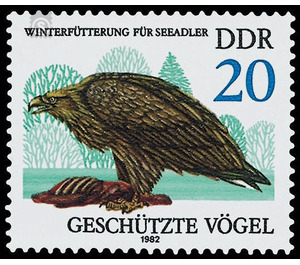Protected birds of prey - Germany / German Democratic Republic 1982 - 20 Pfennig
Theme: Animals
| Country | Germany / German Democratic Republic |
| Issue Date | 1982 |
| Face Value | 20.00 |
| Color | multi-colored |
| Perforation | K 14 |
| Printing Type | Rotogravure 2 |
| Stamp Type | Postage stamp |
| Item Type | Stamp |
| Chronological Issue Number | 2445 |
| Chronological Chapter | GER-DDR |
| SID | 23721 |
| In 22 Wishlists | |
Protected birds With the illustrations of protected birds, the Ministry of Posts and Telecommunications of the German Democratic Republic issues four multicolored special postage stamps. Special Cancellation from May 18 to July 17, 1982 Protected Birds Our birds of prey, as the final members of food chains, are among the most endangered species of birds as a result of the world's increased environmental pollution. Seven birds of prey occurring in the GDR were classified as "threatened with extinction" on the basis of § 14 of the Nature Conservation Order of 14 May 1970 and the order to protect wild plants and non-huntable, wild animals of 6 July 1970 and thus have the highest protection status. 20 Pfennig value: Sea Eagle at the winter feeding Our largest native eagle is the sea eagle. He prefers the proximity of waters. Here he beats his prey, especially Bleßrallen, wild ducks, divers, wild geese, fish, sometimes also mammals and carrion. Due to the broad food spectrum, the adult birds also stay in the breeding area after the breeding season, as long as the food is secure, or look for other ice-free river meadows or Bodden waters on our Baltic Sea coast. Special horst protection measures, such as the exclusion of the management of forest areas in the 100-m radius around the Horstplatz and implementation of utilization in the 300-m radius only outside the courtship, breeding and rearing of the boys, suppression of any disturbances during breeding season, gradual reduction The contamination of foreign food in the food chain as well as the feeding of the overwintering white-tailed eagle during extreme times of emergency led to the fact that in the GDR again a long-term constant existence of 100 breeding pairs occurs. The GDR is thus home to Norway's second largest stock in Europe.


